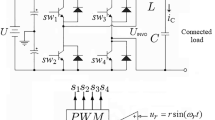Abstract
This paper proposes two current-control strategies adopting the sliding-mode concept for single-phase current-source inverters (CSI) feeding a resistive load. The first strategy is based on forming a general sliding surface using the error variables of the inductor current and capacitor voltage. However, it is observed that with this type of control there exists a steady-state error in the capacitor voltage. Therefore, an integral sliding-mode-based current control using an additional integral term of the error variables in the sliding surface is proposed. It is observed that the additional integral term alleviates the steady-state error in the capacitor voltage. The existence conditions for stability are determined for both control strategies. It is shown that the compliance of the existence conditions for full operating range of the CSI can be assured if the complete ranges of operating conditions are taken into consideration. In order to reduce the switching losses and improve the quality of the output voltage, the three-level hysteresis function is implemented as two separate two-level functions for the switching devices. Computer simulations are performed to verify the theoretical results and for comparison with existing methods. Experimental results are also presented to support the theoretical considerations.
Similar content being viewed by others
References
Espinoza J, Joos G, Ziogas P (1998) A current-source-inverter-fed induction motor drive system with reduced losses. IEEE Trans Ind Appl 34(4): 796–805
Moschopoulos G, Joos G, Ziogas PD (1994) Input characteristics of variable modulation index controlled current source inverters. IEEE Trans Ind Electron 41(2): 216–223
Kazerani M, Zhang ZC, Ooi BT (1995) Linearly controllable boost voltages from tri-level PWM current-source inverter. IEEE Trans Ind Electron 42(1): 72–77
Yin Y, Wu AY (1998) A low-harmonic electric drive system based on current-source inverter. IEEE Trans Ind Appl 34(1): 227–235
Zmood DN, Holmes DG (2001) Improved voltage regulation for current source inverters. IEEE Trans Ind Appl 37(4): 1028–1036
Loh PC, Holmes DG (2005) Analysis of multiloop control strategies for LC/CL/LCL-filtered voltage-source and current-source inverters. IEEE Trans Ind Appl 41(2): 644–654
Colli VD, Cancelliere P, Marignetti F, Stefano RD (2006) Voltage control of current source inverters. IEEE Trans Energy Convers 21(2): 451–458
Chen Y, Smedley K (2006) Three-phase boost-type grid-connected inverters. In: Proceedings of the 21st annual IEEE applied power electronics conference and exposition (APEC’06), pp 791–797
Kwak S, Toliyat HA (2006) Multilevel converter topology using two types of current-source inverters. IEEE Trans Ind Appl 42(6): 1558–1564
Kwak S, Toliyat HA (2006) A current source inverter with advanced external circuit and control method. IEEE Trans Ind Appl 42(6): 1496–1507
Cancelliere P, Colli VD, Stefano RD, Marignetti F (2007) Modeling and control of a zero-current-switching DC/AC current-source inverter. IEEE Trans Ind Electron 54(4): 2106–2119
Suh Y, Steinke JK, Steimer PK (2007) Efficiency comparison of voltage-source and current-source drive systems for medium- voltage applications. IEEE Trans Ind Electron 54(5): 2521–2531
Li RTH, Chung HSH, Chan TKM (2007) An active modulation technique for single-phase grid-connected CSI. IEEE Trans Power Electron 22(4): 1373–1382
Baronian AJ, Dewan SB (1995) An adaptive digital control of current source inverter suitable for parallel processing inverter systems. In: Proceedings of the 30th annual IEEE industry applications conference (IAS’95), pp 2670–2677
Xu F, Ma H, Zhang Y (2006) A discrete-time sliding mode controlled current-source inverter used in AC power source. In: Proceedings of the 37th IEEE power electronics specialists conference (PESC’06), pp 1–5
Kömürcügil H (2007) Passivity-based control of single-phase PWM current-source inverters. In: Proceedings of the 33rd annual conference of the IEEE Industrial Electronics Society (IECON’07), pp 545–550
Kükrer O, Kömürcügil H, Doganalp A (2006) Sliding mode control of single-phase UPS inverters using a three-level hysteresis switching function. In: Proceedings of the 32nd annual conference of the IEEE Industrial Electronics Society (IECON’06), pp 331–335
Utkin V, Guldner J, Shi JX (1999) Sliding mode control in electromechanical systems. Taylor and Francis, London
Kömürcügil H (2010) Steady-state analysis and passivity-based control of single-phase PWM current-source inverters. IEEE Trans Ind Electron 57(3): 1026–1030
Kükrer O, Kömürcügil H, Doganalp A (2009) A three-level hysteresis function approach to the sliding-mode control of single-phase UPS inverters. IEEE Trans Ind Electron 56(9): 3477–3486
Author information
Authors and Affiliations
Corresponding author
Rights and permissions
About this article
Cite this article
Kömürcügil, H. Integral sliding-mode-based current-control strategy for single-phase current-source inverters. Electr Eng 93, 127–136 (2011). https://doi.org/10.1007/s00202-011-0197-3
Received:
Accepted:
Published:
Issue Date:
DOI: https://doi.org/10.1007/s00202-011-0197-3




